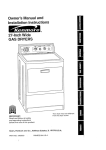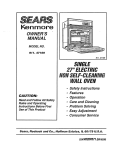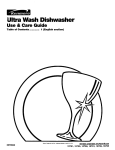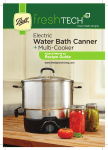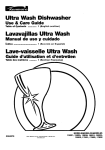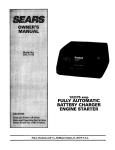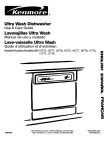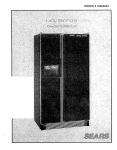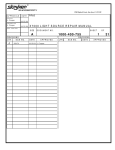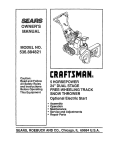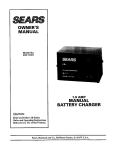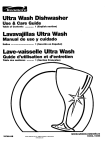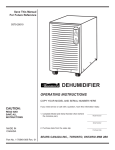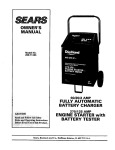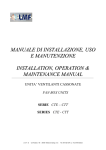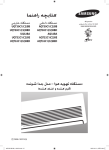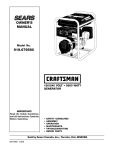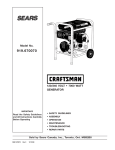Download Kenmore 15831 Dishwasher User Manual
Transcript
Ultra
Wash Dishwasher
Use & Care Guide
Table
3378921
of Contents
.............
1 (English
Sears. Roebuck
section)
and CO, Hoffman Estates. IL 6{)179 USA.
MODELSIMODELOS/MODI_LES
15831, 15835, 15838
Table of Contents
Page
Sears Dishwasher Warranty ...........................................
1
)lshwasher Safety ..........................................................
Parts and Features ..........................................................
2
3
America's
Page
Your Part in Cleaning Dishes
Using the detergent dispenser .................................
11
Using the rinse agent dispenser ...............................
Water temperature tips .............................................
12
12
Cycles .......................................................................
Options .....................................................................
13
15
Cleanest Dishes
How the ULTRA WASH* System and ULTRA WASH
Sensor work ...............................................................
4
Start Up Guide
Before using your dishwasher ....................................
5
Special features .......................................................
Caring for Your Dishwasher
Starting your dishwasher for everyday loads ............. 6
Loading Your Dishwasher
Preparing to load your dishwasher .............................
Loading the top rack ...................................................
7
7
Loading the bottom rack .............................................
Loading the silverware basket ..................................
9
10
Quiet operating tips ..................................................
10
Sears Dishwasher
FULL ONE YEAR WARRANTY
16
Cleaning your dishwasher ........................................
Storing your dishwasher ...........................................
16
17
Tips for washing special items .................................
18
Troubleshooting Guide .................................................
We Service What We Sell .............................................
19
22
Sears Repair Services in U.S.A. and Canada ............. 23
Warranty
ON 800 SERIES KENMORE
ULTRA WASH* DISHWASHERS
For one year from the date of purchase, when the dishwasher is installedand operated in accordance with the
instructions provided in the Installation Instructions and Owners Manual, Sears will repair, free of charge, defects in
matedals or workmanship.
=ULL TWO YEAR WARRANTY
ON ELECTRONIC
CONTROL
AND POWER SUPPLY BOARD
For two years from the date of purchase, when the dishwasher is installed and operated in accordance with the instructions
provided in the Installation Instructionsand Owners Manual, Sears will repair or replace, free of charge, the electronic module
and power supply board if defective in materials or workmanship.
FULL WARRANTY FOR THE LIFE OF THE DISHWASHER
LEAKS IN THE TUB AND INNER DOOR PANEL
ON ULTRA LIFE* TUB MODELS
AGAINST
For the life of the dishwasher if a leak should occur as a result of failure of the polypropylene tub or inner door panel due to
cracking, chipping or peeling, Sears will replace, free of charge, the tub or inner door panel.
LIMITED TWO YEAR WARRANTY
ON THE ULTRA WASH* WASH SYSTEM
After the first year and until two years from the date of purchase, when the dishwasher is installedand operated in accordance
with the instructions provided in the Installation Instructions and Owners Manual, Sears will furnish free of charge, replacement
parts for any part of the ULTRA WASH wash system (motor, pump, spray arms, ULTRAFLOW* water feed tube, motor seals,
and pump gasket) which is defective in materials or workmanship. Customer assumes any labor costs associated with
replacement of these parts.
If the dishwasher is subject to other than private family use, the above warranty coverage is effective for only 90 days.
WARRANTY SERVICE IS AVAILABLE BY CONTACTING THE NEAREST SEARS SERVICE CENTER iN THE UNITED STATES
OR CANADA. This warranty applies only while the product is in use in the United States or Canada. This warranty gives you
specific legal rights, and you may also have other rights which vary from state to state or province to province.
Sears, Roebuck and Co.
Dept. 817WA, Hoffman Estates, IL 60179
_7
Sears Canada, Inc.
Toronto, Ontario, Canada M5B2B8
* Indicates symbol for Trademark
1
Dishwasher
Safety
/
Your safety
and the safety
of others is very important.
We have provided many important safety messages in this manual and on your appliance. Always read and obey all
safety messages.
This is the safety alert symbol.
This symbol alerts you to hazards that can kill or hurt you and others.
All safety messages will be preceded by the safety alert symbol and the word "DANGER" or
"WARNING." These words mean:
You will be killed or seriously injured If you don't
follow instructions,
You _
be killed or seriously injured if you don't
follow instructions,
All safety messages will identify the hazard, tell you how to reduce the chance of injury, and tell you what can
happen if the instructions are not followed.
IMPORTANT
SAFETY INSTRUCTIONS
WARNING
- When using the dishwasher,
follow basic precautions, including the following:
,,Do not operate the dishwasher unless all enclosure
panels are properly in place.
• Read all instructions before using the dishwasher.
• Do not tamper with controls.
• Do not abuse, sit on, or stand on the door or dish racks
of the dishwasher.
,Use the dishwasher only for its intended function.
• Use only detergents or rinse agents recommended for
use in a dishwasher and keep them out of the reach of
children.
• When loading items to be washed:
1) Locate sharp items so that they are not likely
to damage the door seal; and
2) Load sharp knives with the handles up to
reduce the risk of cut-type injuries.
• Do not wash plastic items unless they are marked
"dishwasher safe" or the equivalent. For plastic items
not so marked, check the manufacturer's recommendations.
• Do not touch the heating element during or immediately after use.
- SAVE THESE
• To reduce the risk of injury, do not allow children to play
in or on the dishwasher.
,Under certain conditions, hydrogen gas may be produced
in a hot water system that has not been used for two
weeks or more. HYDROGEN GAS IS EXPLOSIVE.
If the hot water system has not been used for such a
period, before using the dishwasher turn on all hot water
faucets and let the water flow from each for several
minutes. This will release any accumulated hydrogen
gas. As the gas is flammable, do not smoke or use an
open flame during this time.
• Remove the door to the washing compartment when
removing an old dishwasher from service or discarding it.
INSTRUCTIONS
-
|
Parts and Features
Use this section to become familiar with the location and appearance of all parts and features. To help you find information on specific parts or features quickly, page references are included.
®
O Top rack (pg. 7)
Upper spray arm
_) Utensil basket (pg. 8)
_) Fold-down tines (pg. 8)
l_) ULTRAFLOW* water feed tube
_) Bottom rack (pg. 9)
Lower spray arm
_) Model and serial number label (on right side)
_) ULTRA WASH* module (pg. 4)
_) Water inlet opening [in tub wall]
Rack bumper
_1 Heating element
_) Overfill protector
_) Detergent dispenser (pg. 11)
Rinse agent dispenser (pg. 12)
Silverware basket (pg. 10)
NO-FLIP* Clip(s) (pg. 8)
3
America's
Cleanest
How the ULTRA WASH*
Sensor work
Dishes
System
Your dishwasher's new ULTRA WASH Soil Removal
System is designed to give you sparkling clean dishes in
the shortest amount of time with the least amount of
energy necessary. The ULTRA WASH System includes:
• A heavy duty grinder that acts as a food disposer to grind
and dispose of large food particles.
• An ULTRA WASH Sensor that monitors the soil level in
the wash load and adjusts the cycle accordingly.
Here's
System
how
the ULTRA
WASH
Soil
Removal
works:
1. When you load the dishwasher, all you need to do is
remove bones, large chunks, or burned-on food. Any
remaining food will be ground up and disposed.
2. Hot water fills the dishwasher to a level near the
bottom of the overfill protector.
3. While the water is heated, the Water Heating indicator
on the control panel glows and the cycle time on the
electronic display holds.
4. When the water reaches the proper temperature, the
Water Heating indicator turns off and the cycle time
countdown resumes.
5. Detergent is added at the correct times from the
detergent dispenser, and hot water is pumped through
the ULTRA WASH pump.
6. Food particles are removed from dishes, pots and
pans, tableware, and cutlery as the dishwasher sprays
a mixture of hot water and detergent through two spray
arms against their soiled surfaces.
7. Food soil in the dishwasher is held in an accumulating
chamber so it does not recirculate into the dishwasher.
8. Water is pumped again through the ULTRA WASH
pump to remove soil particles from the water, and
"hold" them in the accumulating chamber I_1.
9. Soil in the ULTRA WASH Soil Removal System is
disposed down the drain with the wash water I'EI.
10. Fresh, hot water enters the dishwasher, sprays on the
dishes to rinse them, and the rinse water is pumped
through the ULTRA WASH System to remove any
remaining soil.
11. Soil that is held in the ULTRA WASH Soil Removal
System is disposed down the drain with the
rinse water.
12. Final rinse water is heated and a rinse agent is added
to prepare the dishes for drying.
and ULTRA WASH
How the ULTRA WASH Sensor adjusts
the cycle:
• When the Sensing indicator light on the control panel
glows, the ULTRA WASH Sensor is measuring the
amount of soil in the dishwasher.
• Once the soil level is determined, the dishwasher skips
any unnecessary portions of the cycle. The cycle countdown display is adjusted automatically.
• For lighter soil loads, the dishwasher will use fewer
water exchanges and shorten the cycle time. Example:
A 90-minute Normal cycle with a light soil level adjusts
to a 70-minute Normal cycle (including dry time).
Start Up Guide
Before
using your dishwasher
Tip Over Hazard
Electrical Shock Hazard
Do not use dishwasher until completely
installed.
Electrically ground dishwasher.
Do not push down on open door.
Connect ground wire to green ground
connector in terminal box.
Doing so can result in serious injury or cuts.
Do not use an extension cord.
Failure to do so can result in death, fire, or
electrical shock.
GROUNDING
• For a grounded, cord connected dishwasher:
The dishwasher must be grounded. In the event
of a malfunction or breakdown, grounding will reduce
the risk of electric shock by providing a path of least
resistance for electric current. The dishwasher is
equipped with a cord having an equipment-grounding
conductor and a grounding plug. The plug must be
plugged into an appropriate outlet that is installed
and grounded in accordance with all local codes
and ordinances.
WARNING
- Improper connection of the equipment grounding conductor can result in a risk of
-SAVE
INSTRUCTIONS
electric shock. Check with a qualified electrician or
service representative if you are in doubt whether the
dishwasher is properly grounded. Do not modify the
plug provided with the dishwasher; if it will not fit the
outlet, have a proper outlet installed by a qualified
electrician.
• For a permanently connected dishwasher:
The dishwasher must be connected to a grounded
metal, permanent wiring system, or an equipmentgrounding conductor must be run with the circuit
conductors and connected to the equipment-grounding terminal or lead on the dishwasher.
THESEINSTRUCTIONS-
Starting
your dishwasher
for everyday
Here is an overview for loading and running your dishwasher. Refer to the noted pages for more details of
each step.
1. The ULTRA WASH* Soil Removal System is designed
to remove food particles from the wash and rinse water.
Remove only large chunks of food and bones from
your dishes.
2. Properly load the dishwasher I_1. Make sure nothing
prevents the spray arms from spinning freely I'_1. See
page 9.
3. Add detergent [] and check the rinse agent dispenser.
Add rinse agent if needed I'_1. See pages 11 and 12.
4. Push door firmly closed it. The door latches automatically. Run hot water at the sink nearest your dishwasher
until water is hot ll. Turn off water. See page 12.
5. Press the desired Cycle and Options selections Ir_.
see pages 13-15. Press the Start pad I]!.
loads
Loading Your Dishwasher
This section tells you how to load your dishwasher properly for the best washing and rinsing results.
Preparing
to load your dishwasher
• Load correctly for best washing results. Incorrect loading
may cause poor washing and the need to rewash all or
part of the load.
• Wash full loads. Running a half-filled dishwasher uses
the same amount of electricity and hot water as a fully
loaded machine.
• To save water and energy, do not rinse dishes before
putting them into the dishwasher.
• Remove large pieces of food, fruit pits, bones, and other
hard items. The ULTRA WASH* module will remove food
particles from the water. The module contains a chopping
device which will reduce the size of food items.
NOTE: If hard items such as fruit seeds, nuts, and egg
shells enter the ULTRA WASH module, you might hear
chopping, grinding, crunching, or buzzing sounds. Those
Loading
the top rack
The top rack is designed for cups, glasses, and smaller
items. See [] & I'_Jl.
• Place items so open ends face down for cleaning and
draining.
• Load glasses in top rack only - bottom rack is not
designed for glasses. Damage may occur.
• Place cups and glasses in the rows between prongs.
Placing them over the prongs can lead to breakage.
• Secure lightweight items.
• China, crystal, and other delicate items must not touch
each other during dishwasher operation. Damage
may occur.
• Load plastic items in the top rack only. Only plastic items
marked "dishwasher safe" are recommended.
• Load plastic items so the force of the spray does not
move them during the cycle.
• To avoid chipping, do not let stemware touch other items.
• Small bowls, pans, and other utensils can be placed in
the top rack.
sounds are normal when hard items enter the module.
Do not let metallic items (such as pot handle screws) get
into the ULTRA WASH module. They could damage the
ULTRA WASH module.
• Foods like eggs, rice, pasta, spinach, and cooked cereals
may be hard to remove if they are left to dry over a
period of time. Run a Quick Rinse cycle to keep dishes
moist if you do not plan to wash them soon.
• Load dishes so soiled surfaces face the rotating
spray arms.
• Load dishes so they are not stacked or overlapping, if
possible. It is important for the water spray to reach all
soiled surfaces for best washing. For best drying, water
must be able to drain from atl surfaces.
Loading
the top rack
(cont.)
Utensil basket
Use this convenient basket on the top rack to hold spatulas, wooden spoons, and similar items I_1.
Fold-down tines
Fold the tines in the top rack all the way down to
accommodate larger items I_1.
NO-FLIP*
clip(s)
Use the NO-FLIP clip(s) to hold small, lightweight items in
place during the cycle Ir_.
8
Loading
the bottom
rack
Items with cooked-on or dried-on food should be loaded
in the bottom rack, with soiled surfaces facing inward to
*he spray. See [] & I'_1.
• Do not load glasses, cups, or plastic items in the
bottom rack.
• Load plates, soup bowls, etc., between prongs and
facing inward to the spray.
• Overlap edges of plates for large loads.
• Secure heavily soiled cookware face down in the rack.
• Make sure pot handles and other items do not stop
rotation of the upper or lower spray arm. The spray arms
must move freely.
Fold-down
divider
A fold-down divider at the back of the rack can be lowered
to make room for deep bowls, roasters, and other large
items Ir_l.
9
Loading
the silverware
basket
• Load the silverware basket while it is in the bottom rack
or take the basket out for loading on a counter or table.
NOTE: You can remove the basket for easy unloading.
Always unload or remove the basket before unloading
the racks to avoid spilling water droplets on the silverware.
• Place small items (baby bottle caps, jar lids, etc.) in a
section with a hinged cover. Close the cover over the
section to hold small items in place I_1.
• You can separate the two small baskets from the large
basket [] and position the small baskets elsewhere in
the upper or lower rack.
To remove a small basket:
1. Hold the center basket with one hand, and one of the
small baskets with the other hand.
2. Slide the small basket to release tabs from
corresponding slots.
3. Pull baskets apart.
• Mix items in each section of the basket with some
pointing up and some down to avoid nesting r_l. spray
cannot reach nested items.
IMPORTANT: Always load sharp items (knives, skewers,
forks, etc.) pointing down.
Quiet
operating
tips
To avoid thumping/clattering noises during operation:
• Make sure lightweight load items are secured in
the racks.
• Make sure pot lids and handles, pizza pans, cookie
sheets, etc., do not touch interior walls or interfere with
the spray arm's rotation.
• Load dishes so they do not touch one another.
NOTE: Keep sink drain plugs closed during dishwasher
operation to prevent noise transfer through drains.
10
Your Part in Cleaning
Dishes
Operating your dishwasher properly enables you to obtain the best possible results. This section explains proper
dishwasher operation.
Using the detergent
dispenser
• Use automatic dishwashing detergent only. Other
detergents are too mild and much too sudsy.
• Add detergent just before starting cycle.
• Store tightly closed detergent in a cool, dry place. Fresh
automatic dishwasher detergent results in better
cleaning.
Filling the detergent
dispenser
The detergent dispenser [] has one section with a cover
and one without. Push the cover down firmly until it latches.
Detergent in the open section falls into the dishwasher
when closing the door. The covered section opens automatically for the main wash. It is normal for the cover to
open partially when dispensing detergent.
Cover
Cover latch
NOTE: Use both sections for cycles with two washes. Use
only the covered section for cycles with one wash. See the
cycles chart for more details.
How
much
detergent
to use
• The amount of detergent to use depends on the hardness of your water and the type of detergent. If you use
too little, dishes won't be clean. If you use too much in
soft water, glassware will etch.
• Find out your water's hardness by asking the water
softener department in your local Sears store or your
local water department.
NOTE: Fill amounts shown are for standard powdered
detergent. Amounts may vary if you use liquid or concentrated powdered detergent. Follow instructions on the
package when using liquid dishwasher detergent or
concentrated powdered detergent.
Water Type
Where to fill standard
powdered detergent
Hard
Top of
8+ grains per gallon
136+ parts per million
3rd step
(3 tbs.)
Medium
Top of
5-7 grains per gallon
85-119 parts per million
2nd step
(2 tbs)
Soft
0-4 grains per gallon
0-68 parts per million
Top of
1st step
(1 tbs.)
11
Using the rinse agent
dispenser
A rinse agent greatly improves dish drying and helps
prevent spots or streaks. The rinse agent helps water flow
off dishes and keeps water from forming droplets. A small
amount of rinse agent automatically releases into the final
rinse water.
Keep the rinse agent dispenser filled with a liquid
rinse agent. For best drying results, periodically check the
dispenser as follows to see if it needs filling:
• Check center of rinse aid indicator cap I_1. Clear means
it needs filling.
OR
• Remove rinse aid indicator cap. An "E" is visible at the
bottom of the dispenser when empty I'11.
To fill dispenser:
1. Open dishwasher door completely.
2. Remove rinse aid indicator cap.
3. Add rinse agent IrJ. Fill only to smallest opening in
lower part of dispenser. Overfilling may cause rinse
agent to leak out. This will not harm the dishwasher, but
could cause oversudsing.
4. Clean up any spilled rinse agent with a damp cloth.
5. Replace rinse aid indicator cap. Keep it closed tightly.
NOTES:
• Your dishwasher is designed to use a liquid rinse agent.
Do not use a solid or bar-type rinse agent.
• The rinse agent dispenser holds 6 ounces (175 mL).
Under normal conditions, this lasts about 3 months.
• You do not have to wait until the dispenser is empty
before refilling, but do not overfill it.
Water
temperature
tips
f
Hot water dissolves and activates the dishwashing detergent. Hot water also dissolves grease on dishes and helps
dry glasses spot-free. For best dishwashing results, water
must be at least 120°F (49°C) as it enters the dishwasher.
Loads may not wash as well if the water temperature is
too low.
f
NOTE: Use the Water Heat option on your dishwasher if
you keep your water heater at a low setting. The time
showing on the electronic display pauses while water is
heating. For more information, see "Dishwasher seems to
run too long" in the "Troubleshooting Guide" section.
To check water temperature:
1. Run hot water at the faucet closest to your dishwasher
for at least 1 minute.
2. Measure the water temperature with a candy or meat
thermometer placed in the running stream of water I'_11.
3. If the water temperature at the faucet is below 120°F
(49°C), have a qualified person raise the water heater's
thermostat setting.
12
II
Cycles
f
Ultra Wash Sensor
Q
I
SENSING
POTS
PANS
WASHING
NORMA
WASH
WATER
MISER
I ('l'1"l'l'l
QuietGuard System
CHINA
WASH
(_QA_N
WATER HEATING
CONTROI_LLOCK
""
QUICK
RINSE
SENSINGCYCLES
R
•
I
1
J
A "#'" shows what each cycle includes.
Soil Level
Detected By
Ultra Wash
Sensor
CYCLE
POTS &PANS
•
Main
Wash Rinse Wash Rinse
Heavy
,/
Light
,/t
,/t
Final
Heated
Rinse
Cycle
Timetr
Dry Imin.)
Water
Usage
(gallons/
liters)
,/t
,/
,/t
,/
96.
10.8/40.9
,/t
,/
,/t
,/
80 tt
8.6/32.6
POTS
PANS
Detergent
Dispenser
Sections
D
D
Use Both
Sections
For cleaning dishes, and pots and pans with cooked-on or baked-on foods.
NORMAL WASH
r
NORMAL
WASH
Heavy
/
Medium
,/
,/
,/t
,/
,/t
,/
90 tt
10.8/40.9
,/t
,/
,/t
,/
86 tt
8.6/32.6
i
i
D
D
Use Both
Sections
Light
,/
,/
,/t
,/
70 tt
6.5/24.6
For everyday heavily soiled dishes. (The Energy Guide label is based on this cycle.)
"Select the Water Heat option to heat water to 135°F (57°C) in the main wash.
WATER MISER
Heavy
I
,/
,/t
,/t
,/
70tt
6.5/24.6
,/
,/t
,/
60_
4.3/16.3
MISER
ATER
Light
D
D
Use
Covered
Section
For prerinsed and lightly soiled dishes. Saves energy by using less hot water than Normal Wash cycle.
• Select the Water Heat option to heat water to 135°F (57°C) in the main wash.
t Water automatically
heats to 135°F (57°C).
tt Cycle time includes dry time and may be longer depending on the temperature of water entering the dishwasher.
longer the cycle time. It the water is already hot enough, the cycle times will be as shown.
The cooler the water, the
The electronic time display pauses while water is being heated and Water Heating status indicator glows while water is being heated to the
temperature shown.
NOTE: You can add a dirty dish if the Washing status indicator is on. Opening the door will not affect the sensor.
13
Cycles
(cont.)
r
Ultra Wash Sensor
I
I
SENSING
WASHING
I
•
QuietGuard System
I
I
I
WATER HEATING
I
I
CLEAN
CONTROL
LOCK
I
IOIOOC""
I(" IO"ALIWTE
POTS
PANS
WASH
MISER
WASH
]
RINS
SENSING CYCLES
OPTIONS
J
A ",/" shows what each cycle includes.
Soil Level
Detected By
Ultra Wash
Sensor
CYCLE
Main
Wash Rinse Wash
Rinse
Final
Heated
Rinse
CHINA WASH
Heavy
WASH
CHINA
,/
Cycle
iTime tt
Dry Imin.)
Water
Usage
(gallons/
liters/
,/
,/t
/
70tt
Cycled
6.5/24.6
j
,/t
/
60tt
Cycled
4.3/16.3
D
D
I
Light
Detergent
Dispenser
Sections
Use
Covered
Section
A light wash and gentle dry for china and crystal. During heated dry, the heating element cycles on and off during that
portion of the cycle.
QUICK RINSE
Heavy
J
,/
18
4.3/16.3
J
14
2.2/8.3
RINSE
Light
D
No
Detergent
Needed
For rinsing dishes that will be washed later.
t Water automatically
heats to 135°F (57°C).
tt Cycle time includes dry time and may be longer depending on the temperature of water entering the dishwasher. The cooler the water, the
longer the cycle time. If the water is already hot enough, the cycle times will be as shown.
The electronic time display pauses while water is being heated and Water Heating status indicator glows while water is being heated to the
temperature shown.
NOTE; You can add a dirty dish if the Washing status indicator is on. Opening the door will not affect the sensor.
14
Options
f/_
U/tra Wash Sensor
SENSING
WASHING
•
QuietGuard System
WATER HEATING
O
_
O
O
O
POTS
PANS
ORMA
WASH
WATER
MISER
CHINA
WASH
QUICK
RINSE
CLEAN
91,
CONTROL
LOCI(
O
SENSINGCYCLES
j
Option
When should I use it?
Water Heat
• Automatic with Pots & Pans
To ensure water temperature in
Main Wash reaches 135°F
(57°C).
• When you select Water Heat, main wash
delays until water heats to 135°F (57°C).
• As water heats, washing action continues.
Water Heating status indicator glows and
electronic time display pauses until water
reaches proper temperature.
No Heat Dry
• Option for Pots & Pans,
Normal Wash, Water Miser
and China Wash cycles
Use when you do not need a
rapid dry cycle. Allow longer
drying times (overnight). Use
rinse agent to improve drying.
• Turns off heating element in 30-minute dry
period.
Delay Start
• Option for any cycle
Use when you want to start a
cycle later.
• Delay beginning of your selected cycle and
options in one hour increments up to nine
hours.
• To set:
• Option for Normal Wash and
Water Miser cycles
• Not available for China Wash
or Quick Rinse cycles
Set delay to run dishwasher
during times when off-peak
utility rates are in effect or
when you are away from home.
Local utilities recommend this
to avoid heavy usage of energy
at certain times of day.
What does it do?
1. Press cycle and option pads.
2. Press Delay Start pad. Increase delay one
hour for each press of Delay Start pad.
Total delay time appears on electronic
time display.
3. Press Start pad. Once Start pad is
pressed, delay begins. Delay time displayed on control panel flashes once.
Cycle and options begin as soon as delay
time expires. If Start pad is not pressed
within 30 seconds of final selection, you
need to re-select your cycle, options and
delay settings.
• You can change cycle and option selections
any time during delay period. You can also
eliminate the delay by pressing Start pad any
time. The dishwasher will start immediately.
15
Special
features
Start Button Memory
To cancel
• To use last full cycle and options completed, press the
Start pad.
• If you do not run dishwasher daily, close door to maintain
memory.
• If power is off or door is open for an extended period of
time, the Start button memory will default to Normal cycle
with Heat Dry.
• Press Cancel.Drain. Wait for 2-minute drain to complete.
To change a cycle
• Press Cancel.Drain. Wait for 2-minute drain to complete.
Reset dishwasher for desired cycle and options. (Remember to add detergent if dishwasher has already gone
through wash portion of original cycle.)
OR
a cycle
Control Lock
• Prevent accidental cycle selections by "locking" controls.
• To lock controls: Press and hold No Heat Dry pad for
4 seconds, Control Lock status indicator glows when
controls are locked.
• To unlock controls: Press and hold No Heat Dry pad for
4 seconds. Control Lock status indicator will flash and
turn off.
• if you try to set cycles or options when controls are
locked, Control Lock status indicator will flash so you
know cycles or options cannot be selected until controls
are unlocked,
• You can change cycle and options any time during first
2 minutes of cycle (while water is entering dishwasher)
without pressing Cancel-Drain.
Caring for Your Dishwasher
Your new dishwasher is designed to give you many years of dependable service. There are a few things you can do to
maintain your dishwasher properly. This section tells you how to clean and care for your dishwasher. Refer to the
"Troubleshooting Guide" section for special cleaning problems.
Cleaning
Cleaning
your dishwasher
the exterior
In most cases, regular use of a soft, damp cloth or sponge
and a mild detergent is all that is necessary to keep the
outside of your dishwasher nice looking and clean I_1.
Cleaning
the interior
Hard water minerals may cause a white film to build up on
the inside surfaces, especially just beneath the door area.
To clean interior:
• Apply powdered dishwasher detergent to a damp sponge
to make a paste.
OR
• Use liquid automatic dishwasher detergent and clean
with damp sponge I'11.
Do not clean the dishwasher interior until it has cooled.
Wear rubber gloves. Do not use any type of cleanser
other than dishwasher detergent because it may cause
foaming or sudsing.
16
Storing
Moving
your dishwasher
or winterizing
your
dishwasher
_,rotect your dishwasher and home against water damage
due to freezing water lines, if your dishwasher is left in a
seasonal dwelling or could be exposed to near freezing
temperatures, have a qualified person do the following:
1. Disconnect power supply to the dishwasher.
2. Turn off water supply to the dishwasher.
3. Remove the 4 screws on the lower access panel and
remove the lower access panel I_1,
4. Place a shallow pan under the water supply valve.
Then, use a wrench to disconnect the water inlet from
the water supply valve. Separate the water inlet from
the water supply valve and drain water into the pan I_1,
J
5. Remove the spring clamp from the water outlet and
separate from the water supply valve; drain water
into pan.
6. Reconnect both water inlet and water outlet to the
water supply valve.
7. Empty the pan and reposition it under the water pump.
8. Remove the clamp and disconnect the drain hose
from the water pump; drain water into pan.
9. Reconnect drain hose to the water pump, being sure
to position the clamp over the connection.
10. Replace the lower access panel.
Reconnecting
your dishwasher
1. Remove the 4 screws on the lower access panel and
remove lower access panel.
2, Turn on the water supply to dishwasher.
3. Turn on power supply to dishwasher.
4. Run dishwasher through a complete cycle and check
for leaks.
5. Replace lower access panel.
NOTE: If your dishwasher is connected to a garbage
disposal, do not run water into the sink after winterizing.
This could cause water to refill the drain hose on your
dishwasher.
Storing
for the summer
Protect your dishwasher during the summer months by
turning off the water supply and power supply to the
dishwasher,
17
Tips for washing
special
items
If you have any doubts about washing a particular item, check with the manufacturer to see if it is dishwasher safe.
MATERIAL
DISHWASHER SAFE?
Aluminum
Yes
EXCEPTIONS/SPECIAL
INFORMATION
High water temperature and detergents may affect
finish of anodized aluminum.
Bottles and Cans
No
Wash bottles and cans by hand. Labels attached with
glue can loosen in your dishwasher. Loose labels and
glue can clog spray arms or the pump and will reduce
washing performance.
Cast Iron
No
Seasoning will be removed and iron will rust.
China/Stoneware
Yes
Always check manufacturer's recommendations before
washing. Antique, hand-painted, or over-the-glaze
patterns may fade. Gold leaf may discolor or fade.
Crystal
Yes
Always check manufacturer's recommendations before
washing. Some types of leaded crystal may etch with
repeated washings.
Gold
No
Glass
Yes
Hollow-Handle
flatware will discolor.
Milk glass will yellow with repeated dishwasher
washing.
No
Handles of some knives are attached to the blade
with adhesives which may loosen if washed in the
dishwasher.
Pewter
No
High water temperatures and detergent may discolor or
pit finish.
Disposable Plastics
No
Cannot withstand high water temperatures and
detergents.
Plastics
Yes
Always check manufacturer's recommendations before
washing. Plastics vary in their capacity to withstand
high water temperatures and detergents. Load plastics
in top rack only.
Stainless Steel
Yes
Run a Quick Rinse cycle if not washing immediately.
Prolonged contact with food containing salt, vinegar,
milk products, or fruit juice could damage finish.
Sterling Silver or Silver Plate
Yes
Run a Quick Rinse cycle if not washing immediately.
Prolonged contact with food containing salt, acid,
or sulfide (eggs, mayonnaise, and seafood) could
damage finish.
Tin
Wooden Ware
18
Knives
Gold-colored
No
Can rust.
No
Wash by hand. Always check manufacturer's recommendations before washing. Untreated wood may
warp, crack, or lose its finish.
Troubleshooting
Guide
Dishwasher is not operating properly
PROBLEM ...
CAUSE...
SOLUTION ...
Dishwasher does
not run or stops
during a cycle
Door not closed
Make sure door is closed and securely latched.
Wrong cycle selected
No or improper power
supplied to dishwasher
Refer to the "Cycles" section, page 13.
Check to see if household fuse or circuit breaker is
blown or tripped.
Motor stopped due to
overload
Motor will automatically reset itself within a few minutes.
If it does not restart, call for service.
No water supplied to
dishwasher
Check to see if shut-off valve (if installed) is turned on.
Dishwasher will
not fill
Overfill protector stuck
Check to see if the overfill protector moves up and down
freely. Press down to release.
Dishwasher seems
to run too long
Water supplied to dishwasher is not hot enough
It is normal for the dishwasher to run longer while heating
water. Refer to the "Water temperature tips" section,
page 12.
,,A delay will occur in the main wash if the Water Heat
option is selected.
"Three delays will occur if the Pots & Pans cycle is
selected.
• The final rinse will automatically delay until the water
temperature reaches 135°F (57°C).
Water remains
in dishwasher
Cycle not finished
Wait for the cycle to complete.
Detergent remains
Cycle not finished
Wait for the cycle to complete.
in covered section
Detergent has lumps
Replace with dry, lump-free detergent.
of dispenser
Bottom rack in backwards
Refer to the "Parts and Features" section, page 3 and
reinstall rack if necessary.
White residue
appears on front
of access panel
Too much detergent
was used
Brand of detergent
developing excess foam
Refer to the "Using the detergent dispenser" section,
page 11.
Try a different brand to reduce foaming and eliminate
buildup.
Odor in the
dishwasher
Dishes only washed every
2-3 days
Run a Quick Rinse cycle at least once or twice a day
until full load is accumulated.
Plastic smell of new dishwasher
Run a vinegar rinse, as described on the next page.
Excessive moisture from vent in
dishwasher console
Dishwasher console should be aligned with countertop.
Refer to Installation Instructions for more information.
Condensation on
kitchen counter
Dishes are not cleaned
Food soil left
on dishes
completely
Improper loading
Refer to the "Loading Your Dishwasher" section,
pages 7-10.
Water temperature is too low
Use the Water Heat option. If needed, turn home water
heater up to ensure water entering dishwasher is 120°F
(49°C) minimum. Refer to the "Water temperature tips"
section, page 12.
Use of incorrect, too little,
or ineffective detergent
Use recommended dishwasher detergents only. Refer
to the "Using the detergent dispenser" section, page 11.
Never use less than one tablespoon per load. Detergent
must be fresh to be effective. Nways store detergent in
a cool, dry area.
continued on next page
19
Troubleshooting
Guide (cont.)
Dishes are not cleaned completely (cont.)
PROBLEM ...
CAUSE.,.
SOLUTION...
Food soil left on
dishes (cont.)
Detergent cakes in dispenser
Use fresh detergent only. Do not allow detergent to sit
for several hours in a wet dispenser. Check dispenser
for caked detergent. Clean dispenser when caked detergent is present.
Remove labels before washing bottles and cans or wash
by hand. Refer to the "Tips for washing special items"
section, page 18.
Pump or spray arm
clogged by labels from
bottles and cans
Insufficient fill caused by
low water pressure
Home water pressure should be 20 to 120 psi
(138-828 kPa) for proper dishwasher fill. A booster
pump on the water supply may be necessary if pressure
is too tow.
Slowdown of wash arm due
to high suds
Never use soap or laundry detergents. Use recommended dishwasher detergents only.
Spots or stains on dishes
Spotting and filming
Hard water or high mineral
content in water
Conditioning the final rinse water with a liquid rinse agent
helps eliminate spotting and filming. Keep the dispenser
full with a rinse agent at all times.
Water temperature is too low
Use the Water Heat option. If needed, turn home
water heater up to ensure water entering dishwasher is
120°F (49°C) minimum. Refer to the "Water temperature
tips" section page 12.
Use of incorrect detergents
Use recommended dishwasher detergents only.
Incorrect amount of
detergent
Refer to the "Using the detergent dispenser" section,
page 11. Heavy soil and/or hard water generally require
extra detergent.
Use of ineffective detergents
Detergent should be fresh. Store in a cool, dry place,
preferably in an airtight container. Discard lumpy detergent.
Insufficient fill caused by low
water pressure
Home water pressure should be 20 to 120 psi (138-828
kPa) for proper dishwasher fill. A booster pump on the
water supply may be necessary if pressure is too low.
NOTE: To remove spots and film from dishes, try a
vinegar rinse.
1. Wash and rinse as usual using the No Heat Dry option.
2. Remove all metal items.
3. Put 2 cups (500 mL) white vinegar in a container on
the bottom rack.
4. Run dishwasher through complete washing cycle.
Vinegar will mix with wash water.
Silica film or etching
(silica film is a white
iridescent deposit;
etching is a
cloudy film)
2O
A water chemical reaction
with certain types of glassware. Usually caused by
some combination of soft
or softened water, alkaline
washing solutions, insufficient
rinsing, overloading
the dishwasher, and heat
of drying.
It may not be possible to prevent problem, except by
hand washing. To slow this process, use a minimum
amount of detergent but not less than 1 tablespoon per
load. Use a liquid rinse agent and underload the dishwasher to allow thorough rinsing. Silica film and etching
are permanent and cannot be removed. Use the No
Heat Dry option.
Troubleshooting
Guide (cont.)
Spots or stains on dishes (cont.)
PROBLEM ...
CAUSE ...
SOLUTION ...
White spots on
cookware with
non-stick finish
Seasoning removed by
dishwasher detergents
Reseason cookware after dishwasher washing.
Brown stains on
dishes and dishwasher Interior
High iron content in water
supply
Remove by washing dishes (after food soil has been
removed) with 1 teaspoon to 1 tablespoon of citric acid
crystals added to covered section of detergent dispenser.
Do not use detergent. Follow with a Normal Wash cycle
with detergent. If treatment is needed more often than
every other month, the installation of an iron removal
unit is recommended.
Black or gray marks
on dishes
Aluminum items
Aluminum items should be loaded so that they will not
rub against dishes during washing. Throwaway aluminum
items should not be washed in the dishwasher because
they may break down and cause marking. Aluminum
markings can be removed by using a mild abrasive
cleanser.
Orange stains on
plastic dishes or
dishwasher interior
Large amounts of tomatobased foods in dishes placed
in the dishwasher
Stains may gradually fade over time. Regular use of
heated drying may cause stains to fade slower. Stains
will not affect dishwasher performance. Regular use of
Quick Rinse cycle or No Heat Dry option will reduce the
likelihood of staining.
Dishes
do not dry completely
Dishes are not dry
Dishes are damaged
Chipping of dishes
Dishes do not drain properly
Dishes must have proper water drainage. Do not overload. Refer to the "Loading Your Dishwasher" section,
pages 7-10. Use a liquid rinse agent to speed drying.
Plastics
Some plastics, due to material, may need to be
towel dried.
Rinse agent dispenser
is empty
Refer to the "Using the rinse agent dispenser" section,
page 12.
No Heat Dry option was used
Do not use the No Heat Dry option.
during cycle
Improper loading
Load dishes and glasses so that they are stable and do
not strike together from washing action. Moving rack in
and out slowly will also minimize chipping.
NOTE: Some types of china and glassware are too
delicate for automatic dishwashing and should be hand
washed; for example: antiques, feather-edged crystal,
and similar types.
Noises
I
crunching, or
buzzing
rinding,sounds
grating,
Hard object entered the
Ultra Wash module
Sound should stop when object is ground up.
21
We Service
What We Sell
"We Service What We Sell" is our assurance you can depend on Sears for service. Your dishwasher has added value when you
consider that Sears has service units nationwide, staffed with professionaltechnicians specificallytrained on Sears appliances
and having the parts, tools, and equipment to ensure that we meet our pledge to you ... "We Service What We Sell."
Sears Maintenance Agreement
Maintain the value of your KENMORE Dishwasher with a Sears Maintenance Agreement. Sears dishwashers are designed,
manufactured, and tested for years of dependable operation. Yet, any modern appliance may requireservice from time to time.
The Sears Maintenance Agreement:
• Is your way to buy tomorrow's service at today's prices.
• Eliminates repair bills resultingfrom normal use.
• Allows for as many service calls as required.
• Provides for service by professional Sears Trained Technicians.
• Even if you don't need repairs,the Maintenance Agreement offers an annual preventative maintenance check-up at
your request!
This Maintenance Agreement does not cover original installation,reinstallation,or damage resultingfrom external causes such
as acts of abuse, theft, fire, flood, wind, lightning, freezing, power failure, power reduction, etc.
22
Sears Repair Services in U.S_L and Canada
For the repair or replacement
parts you need
Call7 am - 7 pm, 7 daysa week
1-800-366-PART
(1-800-366-7278)
For in-home major brand repair service
Call24 hours a day,7 daysa week
1-800-4-REPAIR
(1-800-473-7247)
Forthe locationof a SearsRepair
ServiceCenterin yourarea
Call24 hours a day,7 daysa week
1-800-488-1
222
Forinformationon purchasinga Sears
Maintenance Agreementorto inquire
aboutanexistingAgreement
Call9 am - 5 pro, Monday- Saturday
A
1-800-827-6655
The model number of your product is located on
the serial plate beneath the top handle.
When requesting service or ordering parts, always
provide the following information:
• Product Type
• Part Number
• Model Number
• Part Description
For information
America's
Repair Specialists
on parts and service in Canada, call:
1-800-665-4455
23
Notes
24
2/97
Pnnted in US A
3378921
Imp_esso en los EE UU.
aux _tats-Unis
tmp,im_


























